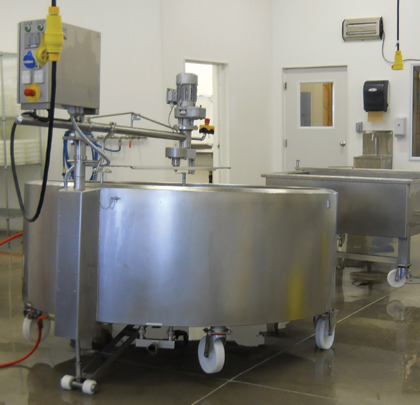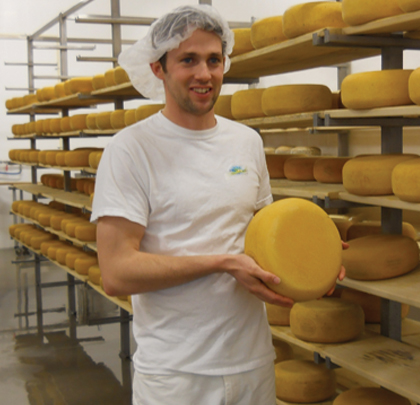Recipes for cheese are thousands of years old, passed down through generations and crossing continents—like the Swiss cheese recipes used by Shep Ysselstein, owner and “grand fromage” of Gunn’s Hill Cheese in Woodstock, Ontario, Canada.
NEW WORLD TECHNOLOGY FOR OLD WORLD TECHNIQUES
Located in the green-grass dairyland of Oxford County, two hours west of Toronto, Gunn’s Hill Artisan Cheese is known for handcrafted, Swiss-style soft, semi-hard and hard cheeses. They are made from recipes that Ysselstein brought back from a one-year study of cheese making in Switzerland. But that Old World recipe is now a New World reality thanks to a secret ingredient: Danfoss VLT® variable frequency drives.
“Cheese making involves processing a lot of fluids,” explains Ysselstein. “We’re pumping thousands of gallons of milk in and out of different vats, stirring in different ingredients, maintaining precise temperatures in a clean environment and lifting and transporting wheels of cheese up to 55 pounds. We depend on Danfoss drives to make this operation move.”
Having earned a business degree several years earlier, Ysselstein opened the small, family-owned enterprise in October 2011. He sells cheese in a retail shop attached to the factory as well as through wholesale operations. A family dairy farm—Friesvale Farms—located next door to the factory, supplies milk.
“Oxford County is famous for being the dairy capital of Canada,” says Ysselstein. “Our family farm has been in business for over sixty years. The quality of the milk comes through in the cheese, especially in the curds. They are immensely rich in flavor and their ‘squeak’ can be enjoyed during a great snack.”
Each of Ysselstein’s three varieties of washed rind cow’s milk cheeses uses slightly different processes. The soft cheese is modeled after a little known Swiss recipe called Mutchli. This mild, creamy cheese is excellent for serving or melting, developing a buttery flavor after just four weeks of aging. The semi-hard recipe combines traits from Gouda and another Swiss variety called Appenzeller. Its creamy, rich flavor has sweet overtones with distinctive eyes in the body of the cheese. The mild version is aged five months and the semi-hard version, twelve months. Finally, the hard variety is a Swiss mountain-style cheese with rich, dry, nutty overtones aged one year. An extra-aged style will be available in two to three years.

Thousands of gallons of milk pass through different vats at Gunn’s Hill.
FLUID AND MOTION CONTROL CHALLENGES
The fluid and motion control required in the process can be seen in the many steps involved in making semi-hard cheeses. Whole Holstein milk is pumped into a cheese vat, where it is pasteurized at 145 degrees Fahrenheit (63 degrees Celsius) for one-half hour. Then, starter culture is stirred into the milk to turn the lactose into lactic acid. An hour later, rennit is added to thicken the milk into a mass, like gelatin. When the milk is at the right thickness, it is cut into small pieces known as “curds.” For semi-hard cheeses, the cut pieces are the size of a kernel. The curds are heated by adding hot water. The hotter the water, the drier will be the cheese as the curds shrink and separate from the liquid whey. The curds are then transferred from the vat to the drain table. Then the whey is removed, while the curds form a mass at the bottom.
Six hours after the milk was first pumped in, the curds are cut into squares and pressed into a round plastic mold, which squeezes out more whey. Pressing can take twenty minutes or overnight, depending on the desired hardness of the cheese. The round wheel of cheese is then immersed into salt brine for two days.
Finally, the cheese is lifted from the brine onto racks where it is aged to develop flavor. The aging room is kept at 54 degrees Fahrenheit (12 degrees Celsius) and 90 percent relative humidity. The cheese is turned every other day and washed with a salt water solution. The outside surface turns an orange color from natural microbes, unlike the dyes used by other cheese makers. After the proper aging time, the cheese is ready to eat—the result of hand craftsmanship and advanced technology.
Throughout the operation, a series of Danfoss VLT® Micro Drives are used to provide pumping and mixing capabilities.
“Using VLT® variable frequency drives was recommended by my HVACR contractor, Ben Kungl, of Oxford Energy Solutions,” explains Ysselstein. “The drives operate our AC pump motors, letting us dial the right speed for a given task.”
“Actually, there are about fifteen VLT® drives used in the plant for a wide range of jobs,” notes Kungl. He himself grew up on an Oxford County dairy farm. After getting technician’s training at a local technical college and working for the award-winning Performance Dairy Centre, he started his own businesses: Oxford Energy Solutions and Oxford Refrigeration.
“There are a lot of old-school ideas about using fixed-speed pumps and motors in dairy processing equipment,” says Kungl. “But in this day and age, you have to be as efficient as you can be.”

Using VLT® drives has given Gunn’s Hill greater control of their process.
INGREDIENTS FOR IMPROVING ENERGY EFFICIENCY
Kungl was able to improve efficiency and control with Danfoss VLT® drives in three areas: fluid pumps, ventilation system and cooling compressor.
He applied three Danfoss VLT® Micro Drives to drive the pumps used to off-load milk from the truck into the raw tank, transfer milk into vats and for washing. “I can set three different speeds without damaging the motors,” says Kungl. “These drives are so easy to program. Pump control can be done either from the drive pad or a PLC.”
“Plus, they convert single phase household AC current to 3-phase,” he adds. “That means we didn’t need to rewire to supply 3-phase current for the heavy commercial motors.” For example, Kungl applied a VLT® drive to control the hoist motor that lifts cheese trays from the brine.
Another VLT® drive is used for ventilation. Regulations require that a food plant have a positive air pressure inside to keep contaminants outside. So a VLT® Micro Drive was applied to the reverse pressurized air handler that supplies the entire facility with 100 percent fresh air.
“It was easy to wire the drive into a pressure transducer,” explains Kungl. “That way, the air handler only needs to supply the make-up air to maintain positive pressure. You can get a small amount of inlet air using 30 horsepower, compared to an old-school fan system using 60 horsepower. That takes a lot of energy, considering you can do the same amount of useful work, get better results and use one-half the horsepower compared to a balanced system with fixed supply and exhaust fan systems.”
Finally, Kungl applied a Danfoss VLT® AutomationDrive FC 302 in a NEMA 12 enclosure to modulate the compressor in the outdoor chiller. The drive serves a dual purpose: to save cost and give the customer a wide range of adaptability.
The chiller modulates between the process cooling for the building and direct cooling for the product after it has been pasteurized and needs to be cooled back down. The FC 302 drive controls the scroll compressor speed and capacity, while two more VLT® Micro Drives control the condenser fan motors for a fully modulating system. These types of condensing units/chillers are a very common product made by Oxford Energy Solutions and have become very popular in food processing and bio-fuel sectors.

VLT® Micro Drives are up to 40 percent smaller than drives with comparable power.
DEPENDABILITY RUNS IN THE VLT DRIVE FAMILY
“The VLT® industrial drive family has an outstanding history of reliability in our company,” states Kungl. “They have a large DC BUS that gives them a very large voltage tolerance. This is why the Danfoss drive product has become one of our company’s flagship product lines.”
“Danfoss VLT® drives are also built in the U.S.A. in nearby Milwaukee, Wisconsin,” adds Kungl. “Unlike other variable frequency drives, these units use algorithms dedicated for flow applications. That simplifies implementation. There are a lot of built-in features—from process PI controller to a Smart Logic Controller that often make a PLC unnecessary. Plus, they can handle up to 122 degrees Fahrenheit ambient temperatures (50 degrees Celsius) without derating, so no special ventilation is needed.
“But basically on a general all-around dairy operation like this one, I simply took advantage of the VLT® drive family’s versatility. For efficiency and reliability, Danfoss VLT® drives can give Gunn’s Hill Artisan Cheese all the flavors of pump and motion control they need.”
Ysselstein agrees: “Without Danfoss drives, I wouldn’t be making good cheese.” ■
_________________________________________________________________________
ABOUT THE AUTHOR
Patrick Appleby is the vice president of industry for Danfoss, a world leader within energy-efficient and climate-friendly solutions for selected industries. For more information, visit www.danfoss.com.
_________________________________________________________________________
MODERN PUMPING TODAY, September 2013
Did you enjoy this article?
Subscribe to the FREE Digital Edition of Modern Pumping Today Magazine!
![]()


